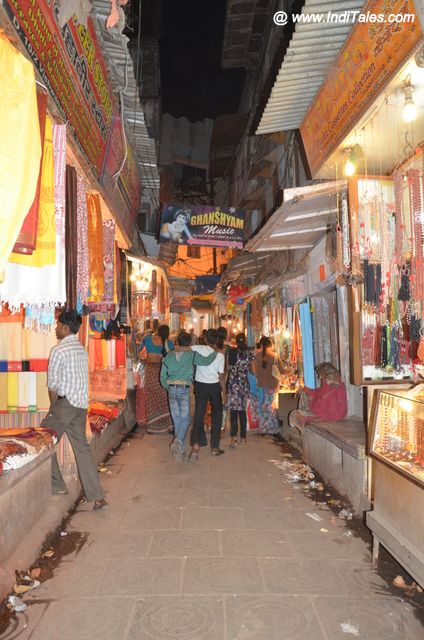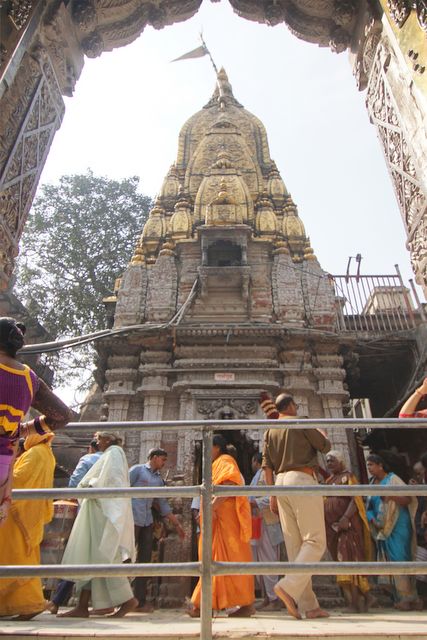KASHI VISHWANATH TEMPLE AT THE HEART OF KASHI YATRA
KASHI VISHWANATH TEMPLE AT THE HEART OF KASHI YATRA
Kashi Vishwanath Temple is at the heart of many pilgrimages. It is one of the 12 Jyotirlingas in India and is considered the most important one. Located in the lanes of Varanasi, it is surrounded by so many temples that you can literally get lost in them. The temple has seen many ups and downs just like its devotees and has changed places in the last thousand years. Come with me for a virtual pilgrimage to Kashi Vishwanath.
Kashi Vishwanath Story
Baba Vishwanath, Vishveshwara, and Kashi Vishwanath are different names of the deity who is the lord of the universe. He is also the presiding deity of Kashi Puri as well as Kashi Kshetra.

Kashi is the city of Shiva. It is said that the city stands on the Trishul or the trident of Shiva. The three Shiva temples in the city mark the three arrows of the Shiva. Vishwanath temple stands on the central arrow and the other two temples are Kedareshwar and Omkareshwar – both of which can be seen in the city.
Skanda Purana
Kashi Khand of Skanda Purana mentions Divodasa as the righteous king of Kashi who ruled the city flawlessly. He took a boon from Brahma that no devatas would set foot in his city. Brahma agreed to this under the condition that everyone in his kingdom should be happy. Meanwhile, Shiva wanted to return to his city, but could not because of this condition. He sent different Devatas like 64 Yoginis, 12 Adityas, his ganas, and Ganesha to turn the situation in his favor. Finally, Vishnu was able to convince Divodasa to let the Shiva come back and preside over the city.
Gyanvapi Well
Gyanvapi well located in the temple predates Ganga in Kashi. It was excavated by Shiva using his Trishul for the Abhishek of Avimukteshwara Linga.

Almost every saint and rishi has visited Kashi and Vishwanath. Many have performed Tapasya here and sung the glories for Vishwanath. Remember the M S Subbulakshmi’s Kashi Vishwanath Suprabhatam. Travelogues of Asi Shankaracharya, Tulsidas, Guru Nanak, and Vivekanand mention both the city and its lord.
History of Kashi Vishwanath temple
Kashi Vishwanath temple is mentioned in the Kashi Khand of Skanda Purana which talks about all the Tirthas in the city of Kashi or Varanasi.
In known history, almost every traveler to the city of Kashi mentions the temple along with the fact that it is the city of Shiva. Being one of the most revered temples in the holiest city of India, it was prone to attacks by the invaders. It faced the first recorded attack in 1194 CE by Muhammad Ghori who did a lot of destruction to the city. Soon Razia Sultan – the empress of Delhi built a mosque at the place of the temple. The temple was moved closer to Avimukteshwar temple nearby.

Then there were attacks by Sikandar Lodhi around the turn of 16th CE. Every time it was destroyed, it was rebuilt by the Hindu kings as well as the millions of pilgrims visiting it every year. The last big attack was done by Aurangzeb who destroyed the temple and built the Gyanvapi mosque on the ruins of the temple. The temple priest jumped in the Gyanvapi well with the Shivalingam to protect it.
Built by Rani Ahilya Bai Holkar
The Vishwanath temple that we see now was built by the Rani Ahilya Bai Holkar of Malwa in 1780 CE. Many Rajputana and Maratha kings tried to re-built the temple but not many of them succeeded. Maharaja Ranjit Singh donated a ton of gold for the temple Shikhara in 1835 CE. Many other kings donated silver, murtis or contributed to building the temple premises.

Pt Madan Mohan Malviya built a new Kashi Vishwanath Temple at the Banaras Hindu University Campus with the support of the Birla family. It was started in the 1930s and was completed in the 1960s. The temple has the tallest Shikharas among all the Hindu temples in the world.
In 2021, the present government built the Kashi Vishwanath Corridor connecting the temple directly to the ghats of Ganga. Earlier you had to take a circuitous route from the ghats to reach the temple, now you can just walk through a wide corridor.
Kashi Vishwanath Temple
Kashi Vishwanath Gali is a narrow lane full of vendors selling all kinds of colorful puja items as well as popular souvenirs from Varanasi. You walk through this narrow lane to reach the Annapurna temple first and then the Kashi Vishwanath temple. The temple is smaller than what you think of it from its stories. Well, it is a temple that is still waiting to be reconstructed in its full glory and at its original place.

You enter through the silver paneled doors into the premises that have many temples. You can recognize the Vishwanath temple both from the crowds that it attracts as well as from the golden Shikhara. The Shivalingam is mounted on a silver Yoni in the Garbhagriha. The temple follows the north Indian Nagara style of architecture, primarily on its Shikharas.
There is a small open mandapa outside the Garbhagriha, which is where you do the darshan from.

There are many small temples surrounding the main temple. Many of them have been moved during the expansion of temple premises for the Kashi Vishwanath Corridor.
Arti’s at Kashi Vishwanath Temple
There are five main Artis that are performed at the temple:
Mangala Arti
Performed early morning around 3:00 AM, it is the first Arti of the day, a ritual to wake up Baba Vishwanath for the day. Only after this Arti, the doors of the temple are opened for the darshan. The Arti includes Shodashopachar or worship with 16 items, Arti, Stuti, and a prayer for the well-being of the universe.
It is quite popular with visitors, pilgrims as well as people of Kashi. Most tour guides would take you to the Mangala Arti early morning, in a kind of a guided tour. You can also do a live darshan provided by the official website of the temple.
Early morning is the best time to visit temples and as you walk around the main temples, you would see and hear the chants from many big and small temples that are in the vicinity of this temple.
Bhog Arti
Performed around Noon time, this is when the Bhog or Prasad is offered to Baba Vishwanath. At this time Rudrabhishek is performed along with Shringar, Stuti, and Arti. Bhog is offered as per the Vara or day of the week or Tithi or the lunar date. For example, only fruit or dairy products are offered on Ekadashi while on other days fruits, puri, halwa, or usual meals are offered. Prasad is given to all present during this Arti. Food is provided to Dandi Swamis after the Bhog Arti.

Saptarishi Arti
Performed after sunset, this is a very unique Arti performed at the temple. It represents the worship by Saptarishis or the seven greatest rishis – Kashyap, Atri, Vasishtha, Vishwamitra, Gautama, Jamadagani, and Bharadwaja. This Arti has roots in Samaveda that is meant to be sung. In the good old days, kings would appoint Brahmins to perform this Arti on their behalf.
Ratri Shringar Arti
Performed around 9 PM, the specialty of this Arti is that Shiva is decorated as the ruler of Kashi called Kashipuradhishwara. This Arti is performed with ancient Vedic rituals that include Shringar, Rudrabhishek, Stuti, Arti, and Bhog.
Shayan Arti
This is the last Arti of the day when the Baba is put to sleep and the doors of the temple closed. It is done by the Kashi Vasis or the residents of the city of Kashi. Usually, after 11 PM, about 40-50 Kashi residents gather in the mandapa and sing the Arti. The crescendo of their singing is worth an experience. Not many visitors are present at this time, so you see a temple that is not too crowded and of course the sheer devotion of the people of Kashi.
Patalakhanda of Padma Purana mentions that in the morning one should take a dip in the Ganga or in the afternoon in Manikarnika Kund and then visit the important temples in this order – Vishwanath, Bhavani or Annapurna temple, Dhundiraja temple, Dandapani, and Kala Bhairava temples. These are the five most important temples for the Kashi pilgrimage.
Kashi Khand mentions a slightly longer pilgrimage including Tarpana for ancestors and visiting temples of all deities including Vishnu and Ganesha.

Festivals at the temple
Mahashivaratri
Shivaratri happens every month on the 14th day of the dark fortnight of the month. In the month of Phalgun, it is celebrated as Mahashivaratri or the biggest night of Shiva. On this day, devotees visit the temple to offer Abhishek and take darshan. Kashi Vishwanath temple stays open through the night on Shivaratri. No Shayan Arti is performed as the temple doors are not closed. Different formats of Arti are used on Mahashivaratri to allow maximum devotees to have darshan.
Rangbhari Ekadashi
Celebrated on the Phalgun Shukla Ekadashi, the festival of colors fills the temples and devotees with colors. Shiva and Parvati Utsava murtis are offered Abira and Gulal – the bright pink colors. Then the devotees play among themselves. Music and dance add to the joy of celebration.

Shravan Somvaar
Shravan Masa or the month of Shravana is the month of Shiva worship. Mondays of this month are considered auspicious to visit the Shiva temples across the country. So, this most important Shiva temple is also full of devotees who want to offer water, milk, curd, or Bilva leaves to Shiva.
Different elaborate Shringars are done on four Mondays of Shravan month.
Akshay Tritiya
It is one of the most auspicious days in the Indian Calendar. On this day Vishwanath is sprinkled with Gangajal using a fountain.
Annakoot
This festival takes place in the month of Kartika, just the day after Deepawali. Chhappan Bhog or 56 different types of dishes are prepared and offered to Shiva and his family during the Bhog Arti.
Dev Deepawali is celebrated on the Kartik Purnima, primarily on the ghats of Ganga when millions of Diyas or earthen lamps are lit up. At the temple too, special lighting is done.
My experience of visiting this temple multiple times says that – Every day is Utsava here.

Travel Tips
- Varanasi is well connected by air, railways, and road.
- Anyone in Varanasi will direct you to Kashi Vishwanath Temple. The time needed depends on the crowds.
- You are not allowed to take any electronic gadgets inside the temple, not even your mobile phone.
- There are many ways to approach the temple. The most popular way is from Vishwanath Gali, then there is an entrance from the Chowk side now and of course the entrance from the Ganga side through Kashi Vishwanath Corridor.
- It is recommended to attend at least one Arti during your visit.
- You can book your visit, stay, and Puja online through the Kashi Vishwanath Temple website.

Comments
Post a Comment